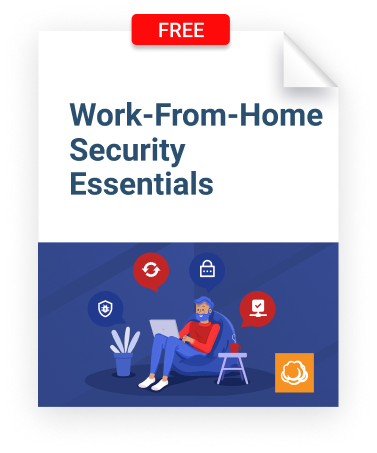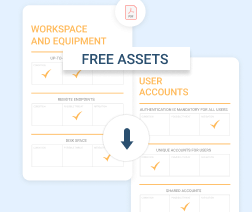Understanding Cloud Security Challenges
In today's increasingly digitized world, businesses rapidly adopt cloud computing to enhance their agility, scalability, and cost-effectiveness. While the cloud offers numerous advantages, it also introduces a new set of security challenges that managed service providers (MSPs) and their clients must address to protect sensitive data effectively.
Further reading Top Security Threats in Cloud Computing and How to Mitigate Them
Shared Responsibility Model
One fundamental concept that organizations must grasp when considering cloud security is the shared responsibility model. Under this model, the cloud service provider (CSP) and the client share security responsibilities, but the extent of these responsibilities varies depending on the type of cloud service being used—infrastructure as a service (IaaS), platform as a service (PaaS), or software as a service (SaaS).
- IaaS: In an IaaS environment, the CSP is responsible for securing the underlying infrastructure, such as servers, storage, and networking, while the client is responsible for securing their applications, data, and configurations.
- PaaS: In PaaS, the CSP takes on more responsibility, including the security of the platform and infrastructure, while the client focuses on securing their applications and data.
- SaaS: With SaaS, the CSP bears the most responsibility, as they manage the entire software application, including infrastructure, platform, and security. However, clients still have a role in securing their data and user access.

Potential Threats and Vulnerabilities
Understanding the potential threats and vulnerabilities affecting cloud environments is crucial for effective security planning. Here are some key challenges and risks:
- Data Breaches: Unauthorized access to data is a primary concern. Whether they are due to weak authentication, misconfigurations, or insider threats, data breaches can lead to significant data loss and reputational damage.
- Misconfigurations: Misconfigured cloud resources are a common cause of security incidents. Improperly configured storage, databases, and firewall rules can expose sensitive data to the public internet.
- Identity and Access Management (IAM) Issues: Poorly managed user access, weak password policies, and inadequate identity verification processes can lead to unauthorized access and data breaches.
Further reading IAM vs PAM vs PIM: Guide to Access Management - Insecure APIs: Application programming interfaces (APIs) are essential for cloud services but can become a security weakness if not properly secured. Vulnerable APIs can be exploited by attackers to gain access to cloud resources.
- Compliance Challenges: Depending on the industry and geography, organizations may need to comply with various regulations and standards (e.g., GDPR, HIPAA, SOC 2) when handling data in the cloud. Non-compliance can result in legal consequences.
- Shared Resources: In multi-tenant cloud environments, multiple clients share the same physical resources. While robust isolation mechanisms are in place, vulnerabilities in shared resources can potentially impact other clients.
MSPs’ Role in Cloud Security
Managed service providers (MSPs) play a pivotal role in ensuring robust cloud security for their clients. As organizations increasingly embrace cloud services to drive efficiency and innovation, the responsibilities of MSPs extend beyond traditional IT management. In this section, we will explore the vital role of MSPs in cloud security and how they can effectively protect their clients' data in the cloud.
Trusted Advisors
MSPs serve as trusted advisors to their clients regarding cloud security. They possess the expertise and experience needed to navigate the complexities of cloud environments. MSPs must stay up to date with the latest security threats, vulnerabilities, and best practices, sharing this knowledge with their clients to make informed decisions.


Security Assessment and Planning
One of the primary roles of MSPs in cloud security is conducting comprehensive security assessments and helping clients formulate robust security plans. This involves:
- Assessing the client's security posture, identifying vulnerabilities, and evaluating current security policies and procedures.
- Collaborating with the client to define security objectives, requirements, and risk tolerance.
- Developing a customized cloud security strategy that aligns with the client's business goals and industry regulations.
Further reading A Security-First Approach to Backup and IT Management: Elevating MSPs in an Age of Increasing Cyberthreats
Vendor Selection and Integration
MSPs assist clients in selecting the right cloud service providers (CSPs) that align with their security and compliance needs. They evaluate CSPs' security practices, data protection mechanisms, and certifications to ensure they meet industry standards.
Once a CSP is chosen, MSPs play a crucial role in integrating cloud services securely into the client's infrastructure. They configure and manage cloud resources, implement security controls, and establish seamless connectivity between on-premises and cloud environments.
Continuous Monitoring and Threat Detection
Cloud security is an ever-evolving landscape, making continuous monitoring and threat detection essential. MSPs employ sophisticated tools and practices to monitor cloud environments for security incidents, unauthorized access, and anomalous activities.
They use security information and event management (SIEM) solutions and cloud-native security tools to detect and respond to security threats promptly. MSPs also establish incident response plans to address security incidents effectively.
Data Encryption and Access Control
MSPs help clients implement data encryption and access control measures in the cloud. They ensure that sensitive data is encrypted in transit and at rest, protecting it from unauthorized access. Access controls, such as role-based access control (RBAC) and multi-factor authentication (MFA), are enforced to limit access to data and resources.
Compliance Management
For clients subject to regulatory requirements, MSPs assist in achieving and maintaining compliance in the cloud. This involves:
- Ensuring that cloud deployments adhere to industry-specific regulations (e.g., GDPR, HIPAA, PCI DSS).
- Conducting regular compliance audits and assessments to identify and rectify non-compliance issues.
- Providing documentation and evidence of compliance to regulatory authorities when required.
Disaster Recovery and Backup
MSPs collaborate with clients to establish robust disaster recovery and backup strategies in the cloud. They ensure that data is regularly backed up, replication mechanisms are in place, and recovery plans are tested for effectiveness.
Implementing Strong Identity and Access Management
Effective identity and access management (IAM) is a cornerstone of cloud security. In a cloud-based environment, where data and resources are often distributed across various platforms and services, ensuring that the right people have access to the right resources at the right time is paramount. In this section, we will explore the importance of implementing strong IAM practices and how managed service providers (MSPs) can help their clients bolster cloud security through robust identity and access management.
Centralized User Identity Management
A fundamental step in implementing strong IAM is centralizing user identity management. MSPs assist clients in establishing a single point of truth for user identities, typically through directory services such as Active Directory or cloud-based identity providers. This centralization streamlines user provisioning and de-provisioning processes and simplifies access control.
Role-Based Access Control (RBAC)
MSPs work with their clients to implement RBAC models that align with the organization's structure and security requirements. RBAC assigns roles and permissions based on job functions, ensuring that users have access only to the resources necessary for their roles. This principle of least privilege minimizes the risk of unauthorized access.
Strong Authentication Methods
Multi-factor authentication (MFA) is a critical component of IAM in the cloud. MSPs encourage clients to adopt MFA solutions that require users to provide multiple forms of identification, such as passwords and one-time codes from mobile apps or hardware tokens, before gaining access. This adds an extra layer of security, mitigating the risk of compromised credentials.
Regular Account Reviews
To maintain the integrity of IAM, MSPs help clients establish procedures for regular account reviews. These reviews evaluate user accounts, permissions, and access levels to ensure they align with current business needs. Any outdated or unnecessary licenses are promptly revoked.
Privileged Access Management (PAM)
Privileged access management is essential for cloud environments. MSPs assist clients in implementing PAM solutions that tightly control and monitor access to secret accounts, reducing the risk of insider threats and unauthorized activities.
Single Sign-On (SSO)
MSPs recommend using SSO solutions, which allow users to access multiple cloud services with a single set of credentials. This enhances user experience while ensuring secure authentication, reducing the risk of password-related vulnerabilities.
Session Monitoring and Logging
Effective IAM includes monitoring and logging user sessions. MSPs help clients implement session monitoring to track user activities, detect anomalies, and respond to security incidents promptly. Comprehensive logs also assist in compliance reporting and forensic analysis.
Password Policies and Management
MSPs assist clients in establishing and enforcing strong password policies. This includes password complexity requirements, expiration policies, and password reuse restrictions. Password management tools may also be employed to securely store and rotate credentials.
Vendor-Provided IAM Services
Cloud service providers often offer IAM services that integrate seamlessly with their platforms. MSPs guide clients in leveraging these services to enhance IAM while capitalizing on the built-in security features provided by the cloud provider.
Education and Awareness
MSPs emphasize the importance of user education and awareness in maintaining strong IAM. They provide training and resources to help clients' employees recognize and report suspicious activities and phishing attempts, and follow best practices for protecting their credentials.
Further reading 8 Dos and Don’ts for Creating a Robust Cybersecurity Training Program
The poster pack includes:
- Best practices for creating strong passwords
- Reminders on how secure passwords should look like
- A chart to check if your password is secure enough


Data Backup and Disaster Recovery
Data backup and disaster recovery (DR) planning are essential to a comprehensive cloud security strategy. In a cloud-based environment, data is distributed across multiple platforms and services, making it crucial to have robust backup measures and contingency plans. In this section, we will explore the importance of data backup and disaster recovery and how managed service providers (MSPs) can guide their clients in ensuring the resilience and availability of their data in the cloud.
1. Data Backup Strategies
MSPs work with their clients to establish effective data backup strategies tailored to their needs. These strategies include:
- Regular Backups: MSPs ensure that data is backed up regularly, with the frequency determined by the client's data change rate and recovery time objectives (RTOs).
- Automated Backups: Automation is key to consistency. MSPs implement automated backup processes to minimize the risk of human error and ensure that data is consistently protected.
- Versioning: Backups often include versioning, allowing clients to restore previous versions of files or databases in case of data corruption or unintended changes.
- Off-Site Storage: Data is securely stored off-site to safeguard against physical disasters that could affect on-premises backups.
2. Disaster Recovery Planning
MSPs assist clients in developing comprehensive disaster recovery plans that encompass cloud environments. These plans include:
- RTO and RPO Objectives: Defining recovery time objectives (RTOs) and recovery point objectives (RPOs) to determine how quickly data and operations need to be restored after an incident.
- Backup Validation: Regularly testing backups to ensure data integrity and the ability to recover critical systems and data.
- Alternate Infrastructure: Identifying alternate cloud or on-premises infrastructure that can be used in a disaster, ensuring business continuity.
- Communication Plans: Establishing communication plans to notify stakeholders and employees during a disaster and providing guidance on response actions.
- Incident Response: Defining clear incident response procedures to address various disaster scenarios promptly.
3. Cloud Redundancy and Failover
MSPs advise clients on implementing cloud redundancy and failover mechanisms to ensure high availability of data and applications. This involves:
- Multi-Region Deployment: Deploying applications and data across multiple cloud regions to mitigate the risk of region-specific outages.
- Load Balancing: Distributing incoming traffic across multiple instances or services to prevent overload and ensure continuous service availability.
- Failover Systems: Setting up failover systems that can seamlessly take over operations in the event of a primary system failure.
4. Cloud-Based Backup Solutions
Cloud-based backup solutions are particularly effective in cloud environments. MSPs leverage cloud backup services that offer features such as:
- Scalability: Easily scaling storage capacity as data grows.
- Automated Scheduling: Automating backup schedules and retention policies.
- Data Encryption: Ensuring that data is encrypted during transit and at rest for enhanced security.
- Integration with Cloud Providers: Seamless integration with cloud platforms for efficient data protection.
5. Continuous Testing and Improvement
MSPs stress the importance of continuous testing and improvement of backup and DR plans. Regular testing, simulation of disaster scenarios, and reviews of recovery procedures help identify and address weaknesses in the plan.







